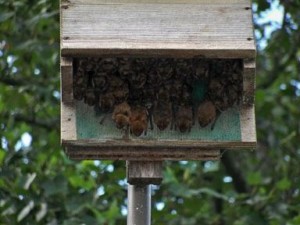-
unique bat houses attractive to humans too!
Increasing in popularity as a better option for natural insect control, bat houses have come a long way in the past few years. Because installation may be on a structure; your house or an out building on the property, as well as a tree or pole, they may remain in full view. Thus some newer styles are more detailed with an aesthetic that encourages folks to utilize them. By quitting the pesticides, your yard will see more birds, butterflies, and more flowers, and a healthier environment all the way around!
This Victorian style bat house is handcrafted in the USA of solid cypress. The shingled roof and slat-front detail are really just for us humans, while the double chamber living quarters with landing pad is attractive to bats. Expect a double-chamber model to house about 100 bats. Cypress offers a stable environment for bats by keeping ambient temperatures level or constant.
A single chamber bat house offers roosting for about twenty or so bats. This is a good way to get started to lure the beneficial furry friends to your place. This vintage style home offers a very cool design element not found with the “standard box” models. Again, handcrafted in solid cypress, it proves to be durable for many years of use.
Either of these fine bat houses would make a unique addition to the landscape. If you happen to be near a pond or creek, chances are favorable at luring occupants. For more information on bats and their benefits, visit OBC, the Organization for Bat Conservation.
-
Consider Bat Houses for Natural Insect Control and more!
Forget the pesticides, they’re literally choking the planet, and with the mild winter we’ve had, you can count on an extremely buggy summer! Because the ground never underwent an extended hard freeze, every creepy-crawly, buzzing and flying pest will witness a bumper crop season! A real nuisance for those who love the outdoors, but it doesn’t have to be….
Birds eat bugs, and bats eat more bugs – by the thousands per night! Although fuzzy, brown bats may appear a little on the eerie side, they are one of the most misunderstood flying creatures of the planet. Actually considered mammals, bats are essential to our ecosystem. Critical, bio-diverse services performed not only include insect control, but pollination and seed dispersal as well. In just about any given habitat; cities, deserts, woodlands, grasslands, rain forests, and your backyard, bat houses provide roosting spots for these beneficial flying mammals. Mounted high on a pole (15 to 20 feet) or on the side of a structure, bat houses will entice permanent residence if habitat is suitable.
The Center for Biological Diversity has published some astonishing numbers as far as bats’ value to farmers. The major concern is the quick-spreading White Nose Syndrome disease which has decimated entire bat populations in the last few years. Emerging in the Northeast, the fatal disease has spread south and west, wiping out complete colonies of cave-dwelling bats.
“Nationwide the loss of bats could mean exploding populations of insects no longer kept in check by these furry, fly-by-night mammals. Scientists have estimated that by keeping insect pests at bay and reducing the need for pesticides, bats are worth $22 billion annually to American farmers. In Colorado, these savings could reach $430 million per year; in South Dakota, $1.1 billion.
While bats are dying at rates topping 90 percent in some areas, and some species could face extinction, the risk to western bats and farmers is too great to justify easing restrictions for discretionary cave uses like recreation.”
The Center is asking for everyone’s help in protecting western bats, and preventing the spread of the deadly fungus. Simply keeping caves closed (nature’s bat houses) to tourism is a simple step in protecting bats and thwarting the war waged against their extinction.
Please take one minute and sign a letter to the U.S. Forest Service, asking for responsible management by maintaining current laws to keep bat caves closed to tourism.
-
Bat Houses and Halloween
This photo was floating around on Facebook and well… I just couldn’t resist! Likely one of the coolest Halloween displays I’ve ever seen.
This post was supposed to be on bat houses because October is supposed to be about bats. Maybe because birds are ignoring feeders and eating the bountiful harvests (in most parts of the country anyway). Texas, I feel for your wildlife and ranch animals too… so so sad. No hay, no water, nothing but parched land.
So, October and bats and Halloween… they’re always portrayed as some scary winged creatures, when in fact they’re pretty harmless. Vampire bats who suck blood exist only in very few places in the whole world. Bats are very beneficial to have around your place, just a small colony can eat tens of thousands of mosquitoes and pests in a night. If you happen to live around a lake or pond you’ve got an advantage for attracting them. Bat Houses offer roosting spots for just a few fellas, all the way up to whole colonies, which are usually around 100 to 300 bats in residential areas.
Wishing everyone a safe and happy Halloween, from me & Shwuppy, the chicken dog!





